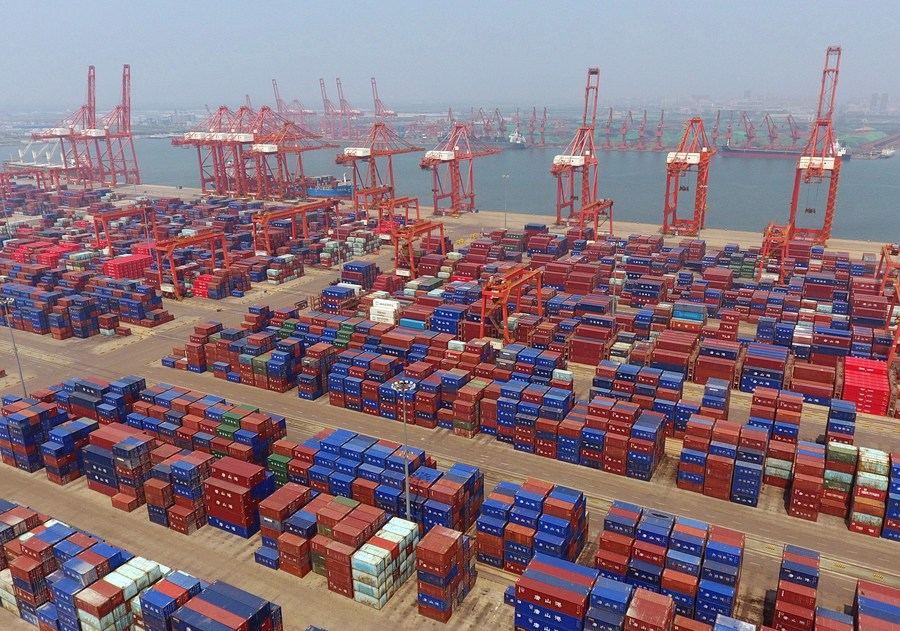

-- Refraining from hastily resorting to massive stimulus measures, China adopted a clear and consistent approach: containing the virus first with stringent public health measures and then rolling out monetary and fiscal policies to revive economic activities.
-- China set virus containment as a top policy priority at the beginning of the outbreak, concentrating medical resources and exercising strong epidemic control despite massive economic costs.
-- The country's fast recovery rests partly with the extraordinary macroeconomic policy mix of raising the deficit, tax relief, cuts in lending rates and banks' reserve requirements.
BEIJING, Dec. 13 (Xinhua) -- China's economy, the first jolted by COVID-19, has bounced back from epidemic fallout with resilience on effective virus control and targeted stimuli, as a pandemic depression continues to threaten the world.
With GDP growth reaching 3.2 percent and 4.9 percent in the second and third quarters, the world's second-largest economy completed the upward leg of a V-shaped recovery from virus-induced lockdowns that sent it into a rare 6.8-percent contraction in the first quarter.
In its latest Economic Outlook report, the Organization for Economic Co-operation and Development predicted that China will be the only major economy to record positive performance in 2020 with 1.8-percent growth.
By the end of 2021, global gross domestic product is projected to reach the pre-pandemic level, with China expected to account for over a third of world economic expansion, according to the report released on Dec. 1.

Photo taken on July 16, 2020 shows a container dock in Tangshan City, north China's Hebei Province. (Xinhua/Yang Shiyao)
As a more encouraging sign, China's exports jumped 21.1 percent year on year in November in U.S. dollar terms, the fastest growth since February 2018, thanks to strong demand for medical goods and electronics.
The brisk recovery has not been easy to come by. Refraining from hastily resorting to massive stimulus measures, China adopted a clear and consistent approach: containing the virus first with stringent public health measures and then rolling out monetary and fiscal policies to revive economic activities.
"COVID-FIRST"
China's "post-COVID rebound is gathering momentum amid a developed world that remains on shaky ground," Stephen Roach, a senior fellow at Yale University, said in an article published by Singapore-based news network Channel NewsAsia.
Roach attributed China's quick economic recovery to the deployment of a "COVID-first strategy" where the country "insulates its citizens from a virulent pathogenic contagion with public health measures" first and then "makes judicious use of monetary and fiscal policy to reinforce the post-lockdown snapback."
This is in sharp contrast with some developed countries where debates focused on using monetary and fiscal policies as frontline countermeasures, rather than taking public health measures to contain the virus in the first place, according to Roach.
Indeed, China set virus containment as a top policy priority at the beginning of the outbreak, concentrating medical resources and exercising strong epidemic control despite massive economic costs.

Workers are seen on the production lines at the workshop of Dongfeng Passenger Vehicle Company in Wuhan, central China's Hubei Province, March 24, 2020. (Xinhua/Xiao Yijiu)
Factories were shut down, schools were closed and many contact-based services such as entertainment and travel were either fully stopped or shifted online to contain the spread of the disease. Masking, temperature monitoring and health QR code scanning have become new norms in the COVID-19 era in China.
When it comes to reopening the economy, China took a targeted and agile approach. Differentiated policies were adopted for economic and social order restoration in different regions, with areas with low-risk of COVID-19 encouraged to return to normalcy first.
Meanwhile, China seemed to be able to perform a delicate balancing act between virus containment and economic recovery thanks to improved testing capacity and tracing.
TARGETED POLICY MIX
The country's fast recovery rests partly with the extraordinary macroeconomic policy mix of raising the deficit, tax relief, cuts in lending rates and banks' reserve requirements.
"Unlike its European and U.S. counterparts, China stayed away from using a deluge of stimulus policies but implemented more targeted counter-cyclical adjustments," said Xu Hongcai, deputy director of Economic Policy Commission of the China Association of Policy Science.
Compared with the 4-trillion-yuan (about 612 billion U.S. dollars) stimulus package China adopted to cope with the 2008 financial crisis, this year's measures were "gentle," said Zhang Yansheng, chief researcher of the China Center for International Economic Exchanges.

People visit the 5G communication services exhibition area during the 2020 China International Fair for Trade in Services (CIFTIS) in Beijing, capital of China, Sept. 7, 2020. (Xinhua/Lu Peng)
To maintain stable liquidity while avoiding money flooding the market, China's central bank put more focus on enabling structural policy tools, including re-lending and rediscount programs.
China's financial institutions saved enterprises 1.25 trillion yuan during the first 10 months, and are expected to save 250 billion yuan more in November and December.
Stabilizing employment has been a macroeconomic policy priority throughout the year, as it closely relates to people's well-being and social stability.
Due to relentless job creation efforts, the country's unemployment rate reached 5.3 percent in October, the lowest of the year. Over 10 million new urban jobs were created during the first 10 months, meeting China's annual target ahead of schedule, according to data from the Ministry of Human Resources and Social Security.
SAFE AND SOUND GROWTH AHEAD
For small and medium-sized businesses -- the main drivers of job creation -- debt and uncertainties remain major challenges.
Xu said he expects macroeconomic policies to continue to focus on protecting market entities and boosting employment next year, which is crucial to stabilizing households' income expectations and increasing their willingness to buy.
"Extraordinary measures should be phased out in 2021 instead of an abrupt exit," Xu said.

Aerial photo taken on June 7, 2020 shows the Tawan Xingshun International Night Market in Shenyang, northeast China's Liaoning Province. (Xinhua/Pan Yulong)
In its third-quarter monetary policy report, China's central bank pledged to make its prudent monetary policy more targeted and flexible to adapt better to the needs of high-quality development and put more focus on the efficiency of financial services to support the real economy.
Morgan Stanley predicted that policymakers will likely normalize credit growth and its fiscal stance next year with a full recovery in the labor market and deployment of COVID-19 vaccines, according to its November report.
Noting that 2021 will be an especially important year for China in advancing modernization, a meeting of the Political Bureau of the Communist Party of China Central Committee on Friday called for sound and precise implementation of macro policies, keeping the economy running within a reasonable range and adhering to the strategy of expanding domestic demand next year.
Reforms on both supply and demand sides should be carried out to achieve a dynamic equilibrium on a higher level, in which demand and supply can boost each other, the meeting said.
"China's overall economic efficiency has improved in recent years due to supply-side structural reforms. As the country will deepen reforms on both supply and demand sides in years to come, the economy will see greater growth potential," Zhang said.

 Award-winning photos show poverty reduction achievements in NE China's Jilin province
Award-winning photos show poverty reduction achievements in NE China's Jilin province People dance to greet advent of New Year in Ameiqituo Town, Guizhou
People dance to greet advent of New Year in Ameiqituo Town, Guizhou Fire brigade in Shanghai holds group wedding
Fire brigade in Shanghai holds group wedding Tourists enjoy ice sculptures in Datan Town, north China
Tourists enjoy ice sculptures in Datan Town, north China Sunset scenery of Dayan Pagoda in Xi'an
Sunset scenery of Dayan Pagoda in Xi'an Tourists have fun at scenic spot in Nanlong Town, NW China
Tourists have fun at scenic spot in Nanlong Town, NW China Harbin attracts tourists by making best use of ice in winter
Harbin attracts tourists by making best use of ice in winter In pics: FIS Alpine Ski Women's World Cup Slalom
In pics: FIS Alpine Ski Women's World Cup Slalom Black-necked cranes rest at reservoir in Lhunzhub County, Lhasa
Black-necked cranes rest at reservoir in Lhunzhub County, Lhasa China's FAST telescope will be available to foreign scientists in April
China's FAST telescope will be available to foreign scientists in April